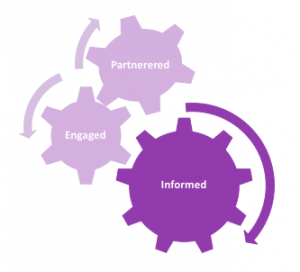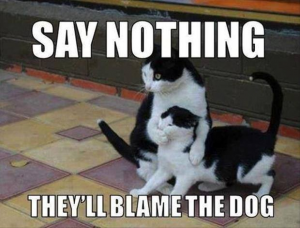PART 3 – The Life Of The Party: Everything You Need To Know About Managing Your Client
13 Chapter 13: Keep Your Client Informed
 Though keeping your client informed, engaged, and partnered all work hand in hand, the biggest driver to a good client relationship is keeping the stakeholders you work with in the know. Metaphorically speaking (and based on the awesome accompanying diagram), it’s what keeps the other cogs turning.
Though keeping your client informed, engaged, and partnered all work hand in hand, the biggest driver to a good client relationship is keeping the stakeholders you work with in the know. Metaphorically speaking (and based on the awesome accompanying diagram), it’s what keeps the other cogs turning.
Yet over the years, outside observers such as clients, alum, and professors alike find students often coming up against the same challenges:
- Not knowing how to balance course and client expectations
- Unwillingly getting involved in the implementation phase
- No/poorly written contract that vaguely describes boundaries and expectations
- No clear follow ups or action items
- Treating clients as the only source of information (works two ways)
- Uncertainty around how, when, where, and with whom to communicate
- Not knowing how to respond or what to say
- Fear and procrastination over sharing bad news
More often than not, your client won’t know what to expect, what kind of project they have to offer, what the business challenges are, and *gasp* that they even have a problem that needs solving. Yes, these situations can be nothing short of overwhelming and frustrating, but you’ve been ‘hired’ as the experts, so you’ll need to proactively take the reigns. Check out Aaron Irizarry’s vlog below starting at 2:37. Though he speaks mainly to an audience of designers, the same advice applies to anyone working with clients – getting the client to trust and rely on you means that you’re responsible for building positive bridges over informational gaps.
What are tactical methods you can employ to strengthen your relationship with your client by keeping them informed? Keep reading to find out.
Setting up Expectations
Much like the need to have an internal baseline for your team, surely you can see by now that formally establishing expectations with your client is incredibly important too.
As you navigate the very preliminary stages of your project, you’ll find that clients may ask the following questions as both teams sort out expectations:
- How do you expect us to support your project?
- We have some project ideas. What is your take on them?
- How many hours do we need to allocate each week for this project?
- Do you work on our premise?
- Can you work on the following deliverables that aren’t part of your project?
Determining Roles
As you would have previously determined, there should be one main contact person on your team to lead up client discussions. You’ll need to also document which roles your stakeholders will play on this project. Typical roles that clients fill are seen next. Please note that sometimes a person can take up more than one role. For information on these roles and the responsibilities of each, Part 5.
- Project Sponsor
- Project Champion
- Project Manager/Team Lead
- Team Members
- Those who complete project tasks. Can include subject matter experts, functional leads, analysts, product owners, etc.
Deliverables and Time Expectations
There are a series of deliverables your team will need to complete over the course of the Capstone project. However, don’t treat them like a school assignments where you’re heads down working toward a mid-term and end-term deliverable. Business is collaborative. Bounce ideas off your client, check in to see if you’re on the right track, have collaborative discussions, stay in touch even if it’s just to say, “we’re still working on it”. If the client doesn’t hear from you in a while, they may interpret that as lack of progress/commitment.
That doesn’t mean that you and the client are figuring out what the deliverables are and when they should be delivered together. Don’t forget, your team is leading this project, so it’ll be your responsibility to call out what your outputs will be and when to expect them. See below for some help.
You may also find that around the time you and the client discuss these deliverables in the early pre-project stages, they ask questions around time commitment. Whether you get asked or not the specific question, “How much time should I dedicate to this project”, you should give your client the heads up that they can expect to spend upwards of 5 hours each week on this project during term one weeks 1-4 and term two weeks 1-4, and anywhere from 2-5 each week in between.
Communications
Let’s be honest, every client is different. That’s why it’s important to have an open and honest conversation at the beginning of the relationship to see what works best in terms of frequency and means of communication (conference call, in-person, email) and then revisit throughout the term to see what is/isn’t working and needs to be tweaked.
Freelancing for Dummies has excellent advice when thinking through client communications. Of their array of tips, most notable are:
- Ask your client when and how they prefer to receive updates (email, phone, in-person)
- Share key information, “where you stand, whether you’re on time, whether you’re experiencing any obstacles (and how you plan on overcoming them), and whether you need any of the client’s help
- Organize thoughts into a brief report and send to the client before the meeting
- Make sure to stick to the delivery dates you’ve agreed upon
- Anticipate which questions the client will be asking you and prepare your responses in advance
When managing communications with your client, there are two noteworthy things to remember:
- Keep it in context – Choose the right communication for the right purpose. For example, face-to-face when it will benefit the discussion, conference call when you need to discuss but in-person isn’t necessary, email for quick updates, etc. When deciding which channels to explore, make use of the same questions outlined in Chapter 3: Securing a Client.
- Make it efficient – Wherever possible, send materials/questions in advance so the client has time to prepare and to make the meeting as effective and efficient as possible
Be sure to document your communications plan using any of the templates found in Part 5 and include it in the contract you share with the client.
Statement of Success
So, you’ve been through this process already (group formation) and are probably wondering why you need another statement of success. Well, just like your other statement ensures that you and your teammates are all on the same page, having a client-facing statement of success also makes certain that you and your client are journeying together in the same direction.
This statement should be a collaboration between your team and key client stakeholders, however, your team is responsible for leading the activity and ensuring that the statement is a thorough, realistic, and measurable reflection of what success looks like when it’s been met. Start with the S.M.A.R.T template found in Part 5 and use it as a launchpad to developing a 1-2 sentences statement of success.
Meetings
Of all the meetings you’ll be having with your client, checkpoint meetings are probably one of the most important. Your team is advised to seriously consider running weekly checkpoint meetings with your client to chat about or demo progress made so far, request information, raise questions, identify challenges and talk about how they can be resolved, and to run through action items. An agenda for these meetings should be prepared and shared with the client in advance.
Other types of meetings you can expect to have with stakeholders are:
- Kick off – project and people intros, getting to know each other
- Info gathering – tours, stakeholder interviews, current process discussions, etc. More discussed in ‘Getting Information’ seen later in this chapter
- Deliverable review – getting client feedback on deliverables before they’re submitted. Can also be working sessions
- Final presentation
Contracts
The culmination of all these expectations should be documented in a contract. A contract is a commonly used business document that helps to paint a clear picture of what both sides of the table are expecting to take place during and after the project. Contracts are also used as a guiding point throughout the project, helping the team to reel it in when things get messy or confusing. Types of contracts you can expect to use:
When reviewing these contracts with your client, it’s not unusual to have a bit of back and forth as both teams try to refine them. Some clients might even get their legal teams involved, but it’s no cause for alarm. When your stakeholders do this, they’re just trying to ensure that everything has been covered and that their business isn’t unnecessarily being put at risk.
Also, be mindful that companies will be sharing quite a bit of private information with you. Even if your client doesn’t get you to sign a confidentiality agreement, part of your professional responsibility is to protect the client and data you’ve been entrusted with. This means that details of your project (even your client’s company name) shouldn’t be shared with anyone outside of your core project team consisting of client stakeholders, group members, your professor, and the BTM department. Even sharing project details with a different client department than the one you’re working for is a no no.
Getting Information
While a lot of emphasis has been put on keeping your client informed, keeping the client involved and engaged also hinges on you getting information as well. Your team will need to gather the appropriate information at the right times in order to make wise and informed decisions (see the cards below). You want, after all, the final solution you offer to be the best possible.




Feedback/Errata